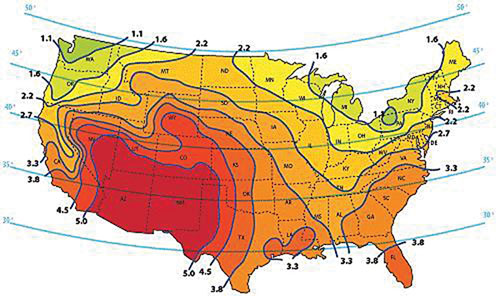Solar Lighting: Making Steps Off-Grid towards a Sustainable Future
The chart that follows is an example of a data set for a specific latitude and longitude in upstate New York. Locations with more peak sun hours can be described as receiving more solar radiation. Availability of solar radiation at a given site will impact system size. Peak sun hour maps show generally how many peak sun hours average for a year are available in different locations of North America or the world. The amount of available solar radiation can differ greatly even within a small geographic area. For example, the state of Texas ranges from 3.3PSH in the east to 5.0PSH in the west of the state.
Determining the optimal tilt angle of the panels for an off grid system differs from a grid tie system. Grid tied systems are most concerned with the maximum average irradiation for the year. Off grid systems are most concerned with optimizing tilt angle to achieve the highest minimum irradiation value during the critical design month. For an off grid system, the critical design month refers to the month with the lowest available radiation levels and subsequently the longest nights. Panel tilt angles for off grid systems that will operate all year long will not benefit by an adjustable tilt angle. Typical off grid systems are sized for the critical design month. For example, December would be the critical design month for someplace like New York State, which has a latitude of about 45 degrees north. In order to optimize power production it is necessary to keep the angle of sunlight perpendicular to the panel. In winter with the sun path being much lower in the sky, using a tilt angle +15 degrees of your latitude will produce the maximum amount of power possible. Having a 60 degree tilt angle in the summer is not optimal, but summer provides more peak sun hours so an optimal tilt angle is not necessary. Once batteries are charged no use can be made of the extra power. Panel orientation is not as critical but typically face due south in the northern hemisphere and due north in the southern hemisphere. When locating your solar luminaires, on site obstructions of panels from sunlight should always be considered. Shading (even partial) of PV modules/arrays can cause disproportional reductions in power output. For this reason it is important to be aware of shading from buildings, trees and other obstructions.
How the Solar Resource is Quantified |
||
Solar resource |
Basic explanation |
Measurement |
Solar Irradiance |
The intensity of solar power |
Watts per square meter (W/m2) |
Solar Irradiation |
The total amount of solar energy accumulated on an area over time |
Units of watt hours per square meter (Wh/m2) |
Source: Photovoltaic Systems 2007 |
||
Â
At a minimum, three pieces of information are required to size a solar lighting system. First and foremost is the location of the site, as described previously. In addition to location, the total input watts of the luminaire including driver or ballast must be known. Finally, the hours per day the luminaire will operate "run time" is defined. Based on these three pieces of information, a system sizing can be done. Although the site location of an installation is a fixed item, luminaire wattage and hours of run time are variables. By adjusting these variables, different size options of panels and batteries may be possible. Whether the emphasis is reduced cost or maximum run time, the system can be adjusted to accommodate specific needs. Another important factor to review when sizing batteries is the quantity of autonomy days required. Days of autonomy refers to the amount of reserve days the battery bank will operate the luminaire without sun. Days of autonomy typically range from three to five days but really depend on location. Certain regions experience more overcast days than others. Seattle, WA, for example, typically experiences a fair amount of overcast conditions and would require more days of autonomy than a location such as Phoenix, AZ, which is known for its sunny weather.
Click on the image to veiw larger details |
Source: Solar Radiation Data Set, National Renewable Energy Laboratories |
 |
Available solar resource in Peak Sun Hours for the United States during winter Source: Solar Insolation Map, U.S. Department of Energy |









